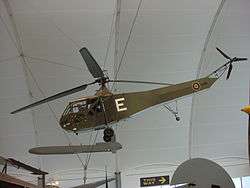No. 529 Squadron RAF
No. 529 Squadron RAF was a radar calibration unit of the Royal Air Force during World War II. The unit had the distinction to be the only RAF unit to fly autogyros and helicopters operationally during World War II.
| No. 529 Squadron RAF | |
|---|---|
| Active | 15 June 1943 – 20 October 1945 |
| Country | |
| Branch | |
| Role | Radar calibration |
| Insignia | |
| Squadron Codes | KX (Jun 1943 – Oct 1945)[1][2] |
History
No. 529 Squadron was formed on 15 June 1943 from No. 1448 Flight[3] at RAF Halton.[4] This flight under the experienced rotary aircraft pilot Squadron Leader Alan Marsh had pioneered radar calibration using Autogyros and light aircraft and the squadron continued to do this until after the end of World War II. On 16 August 1944 the squadron moved to a field at Crazies Farm, Henley-on-Thames[5][6] and on that field they became the first RAF squadron to fly a helicopter for operational use, when they received their first Vought-Sikorsky Hoverfly. It was disbanded on 20 October 1945 at RAF Henley-on-Thames.
Aircraft operated

| From | To | Aircraft | Version |
|---|---|---|---|
| June 1943 | October 1945 | Avro Rota | Mk.Ia |
| June 1943 | October 1945 | de Havilland Hornet Moth | |
| June 1943 | July 1944 | Avro Rota | Mk.II |
| September 1944 | October 1945 | Airspeed Oxford | Mks.I, II |
| May 1945 | October 1945 | Vought-Sikorsky Hoverfly | Mk.I |
Squadron bases
| From | To | Base |
|---|---|---|
| 15 June 1943 | 16 August 1944 | RAF Halton, Buckinghamshire |
| 16 August 1944 | 20 October 1945 | RAF Henley-on-Thames, Oxfordshire |
References
Notes
- Bowyer and Rawlings 1979, p. 64.
- Flintham and Thomas 2003, p. 87.
- Sturtivant and Hamlin 2007, p. 123.
- Rawlings 1982, p. 261.
- Halley 1988, p. 402.
- Jefford 2001, p. 97.
Bibliography
- Bowyer, Michael J.F. and John D.R. Rawlings. Squadron Codes, 1937–56. Cambridge, UK: Patrick Stephens, 1979. ISBN 0-85059-364-6.
- Flintham, Vic and Andrew Thomas. Combat Codes: A full explanation and listing of British, Commonwealth and Allied air force unit codes since 1938. Shrewsbury, Shropshire, UK: Airlife Publishing, 2003. ISBN 1-84037-281-8.
- Halley, James J. The Squadrons of the Royal Air Force & Commonwealth 1918–1988. Tonbridge, Kent, UK: Air Britain (Historians), 1988. ISBN 0-85130-164-9.
- Jefford, C.G. RAF Squadrons, a Comprehensive record of the Movement and Equipment of all RAF Squadrons and their Antecedents since 1912. Shrewsbury, Shropshire, UK: Airlife Publishing, 1988 (second edition 2001). ISBN 1-85310-053-6.
- Rawlings, John D.R. Coastal, Support and Special Squadrons of the RAF and their Aircraft. London: Jane's Publishing Company, 1982. ISBN 0-7106-0187-5.
- Sturtivant, Ray, ISO and John Hamlin. RAF Flying Training And Support Units since 1912. Tonbridge, Kent, UK: Air-Britain (Historians), 2007. ISBN 0-85130-365-X.
